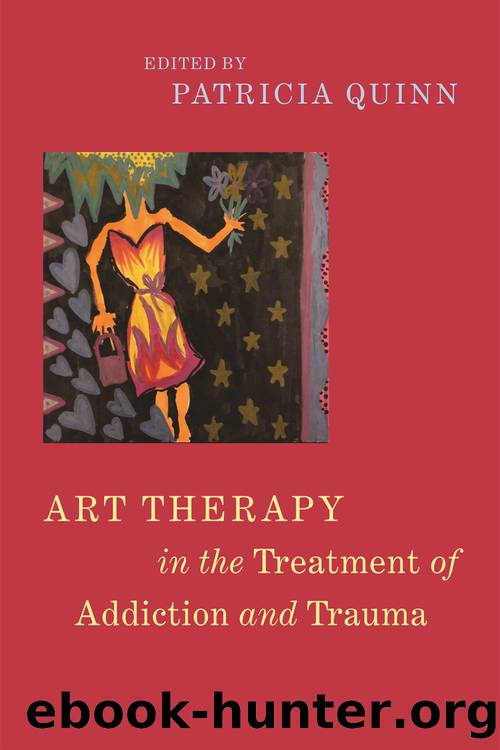Art Therapy in the Treatment of Addiction and Trauma by Patricia Quinn

Author:Patricia Quinn
Language: eng
Format: epub
Publisher: Jessica Kingsley Publishers
Published: 2020-12-21T00:00:00+00:00
Eating disorders and substance use
Among the most common psychiatric comorbidities with eating disorders are mood disorders, anxiety disorders, and SUDs. In a study of more than 2400 individuals hospitalized for an eating disorder, Blinder, Cumella, and Sanathara (2006) found that 97 percent had one or more co-occurring conditions:
⢠94 percent had co-occurring mood disorders, mostly major depression
⢠56 percent were diagnosed with anxiety disorders
⢠22 percent had an alcohol or substance use disorder.
Immediately, given what we know about trauma and how it affects the nervous system and regulatory functions, we can see why these symptoms might go hand in hand. Van der Kolk (2014) points out a circular relationship between PTSD and substance use, saying, âWhile drugs and alcohol may provide temporary relief from trauma symptoms, withdrawing from them increases hyperarousal, thereby intensifying nightmares, flashbacks and irritabilityâ (p.329).
Paula Scatoloni (2019, p.278) states succinctly, âED behaviors serve as a creative strategy to help the individual return to a state of regulation.â Both eating disorder and substance use behaviors can be used as a means of emotional expression and self-regulation. Both help the individual to dissociate and manage more extreme states that feel intolerable. As mentioned previously, each of these disorders can be quite functional in nature, so that an eating disorder or SUD works, until it doesnât any longer. An alcoholic may hold a job for years before their drinking gets to a point where it disables their functioning. Similarly, someone with bulimia may get through college without anyone ever knowing about the behavior, and it may be years before they develop any health issues related to the behaviors. These disorders can remain hidden and are often mired in secrecy and shame. The individual using the symptoms may fear being found outâeven if they know they need help, they are aware that seeking help could mean having these defensive strategies âtaken away.â This perpetuates the cycle of symptoms, and long-term use of those symptoms wreaks havoc on the nervous system, making recovery more complicated on several levels. The body and mind are resilient and will adapt, so many can maintain a level of functioning for some time with the external structure of their symptoms in place. While the symptoms provide a scaffoldâa temporary sense of stabilityâthe person may be operating at a sub-optimal level.
One way I like to illustrate this is by using Maslowâs (1943) hierarchy of needs:
Download
This site does not store any files on its server. We only index and link to content provided by other sites. Please contact the content providers to delete copyright contents if any and email us, we'll remove relevant links or contents immediately.
Should I Stay or Should I Go? by Ramani Durvasula(7538)
Why We Sleep: Unlocking the Power of Sleep and Dreams by Matthew Walker(6598)
Fear by Osho(4644)
Flow by Mihaly Csikszentmihalyi(4618)
Rising Strong by Brene Brown(4363)
Why We Sleep by Matthew Walker(4342)
The Hacking of the American Mind by Robert H. Lustig(4306)
How to Change Your Mind by Michael Pollan(4275)
Too Much and Not the Mood by Durga Chew-Bose(4256)
Lost Connections by Johann Hari(4053)
He's Just Not That Into You by Greg Behrendt & Liz Tuccillo(3822)
Evolve Your Brain by Joe Dispenza(3596)
The Courage to Be Disliked by Ichiro Kishimi & Fumitake Koga(3391)
Crazy Is My Superpower by A.J. Mendez Brooks(3317)
In Cold Blood by Truman Capote(3289)
Resisting Happiness by Matthew Kelly(3287)
What If This Were Enough? by Heather Havrilesky(3262)
The Book of Human Emotions by Tiffany Watt Smith(3222)
Descartes' Error by Antonio Damasio(3209)
